Once a mainstay of households in times gone by, the humble larder provided a practical storage solution for foodstuffs requiring storage over a longer period of time. Nowadays largely a luxury of period properties, larders are eschewed by modern construction due to the dominance of electricity-hungry preservation methods in the form of refrigerators and freezers. We take a look at what larders have to offer and why we should consider bringing them back to life.
Definition of a larder
So what exactly is a larder? The term itself derives from the Old French ‘lardier’, relating to lard or pig fat, signalling that it was originally primarily a space for storing meat, most likely bacon. It soon became used to house a host of many different otherwise perishable foods, however, thanks to the properties inherent in its construction.
Construction of a larder
According to John Henry Walsh, the Victorian author of The English Cookery Book: Uniting a Good Style with Economy, writing in 1859:
The Larder, which is the place set apart for keeping fresh provisions is, and also, in most cases, for the salting of pork, beef, &c., should be placed where it has a thorough draught, and where it is sheltered from the sun. A northerly aspect is therefore the most suitable, or, next to that, an easterly one. The thorough draught cannot always be procured directly; but if it cannot in that way, a large air-drain may be carried under the floor to the opposite side of the house, where a grating may be fixed, and thus a free draught may be obtained. Underground larders are seldom efficient for the keeping of meat, because this perfect draught is not attainable except in windy weather, when there is little difficulty in effecting its preservation; but in moist and muggy weather the air is quite stagnant in the basement story of a town house, and consequently, though tolerably cool, the air is not rapidly changed, and putrefaction goes on without let or hindrance. To fit up a larder for a small house merely requires a number of deal shelves and a door, of which the panels are replaced by plates of perforated zinc, of a pattern sufficiently close to prevent the entrance of flies, yet large enough to admit the air freely. Where there is also a window, it should in like manner be guarded by similar sheets of zinc.
So here we have the most important properties of any properly constructed larder:
- Ventilation, achieved through small windows or openings adequately covered with fine mesh to prevent intrusion by insects or rodents
- Ample storage, usually in the form of slabs or shelves ideally formed from stone or marble
- Coolth (think the opposite of warmth), with larders ideally built to be north or west-facing (south or south-east facing in the southern hemisphere) and as low to the ground as possible in order to best benefit from the thermal mass of the earth to maintain a suitably low temperature in summer months
- Accessibility, usually situated as close to the kitchen/cooking area as possible, although outdoor larders are still to be found, such as the one pictured below
Larders made use of natural materials – stone, earth or cob – in their construction and were often rendered with lime. An additional bowl of quicklime to take in excess moisture in the air kept many a storeroom and pantry dry until the early 21st century, albeit with the downside of being something of a fire risk.
Of course, not many of us are lucky enough to have an already-existing walk-in larder or the space available to incorporate one in the event of a retrofit. All is not lost, however, as it is possible to recreate a larder-like environment using a free-standing cupboard space instead. They arguably score less well when it comes to efficiency (being primarily built from wood) but do offer a viable alternative to storing a variety of food items in place of a fridge. You could even build your own!
Benefits of a larder
The benefits of larders are many, with the most obvious being that they require no electricity. This is in stark contrast to modern-day fridges which, being in use 24 hours a day, can make up a significant proportion of household energy consumption depending on their size, age and rating. Which? estimate that refrigeration appliances account for a whopping £2bn in electricity bills each year in the UK as they’re switched on around the clock, meaning there can be definite financial benefits in addition to the ecological benefits inherent in switching to a larder. There is also the advantage of being able to clearly see your provisions in one central place. Rather than rooting through to the back of a kitchen cupboard to discover long-forgotten purchases, the beauty of the well-managed larder is that it is designed for food to be easily visible, with the result that less of what you buy should go to waste.
So are there any disadvantages? According to this article on the Permaculture website, it may be necessary to adapt your purchasing, storing and eating habits to make best use of your larder. A good level of coolth can be achieved but it admittedly does not achieve quite the chilled environment of an electric refrigerator. Mark Lark recommends that “…foods such as cheese stores well if you remove it from its plastic packing and wrap in paper. Salad keeps surprisingly well – largely due to the airflow that keeps food in a more natural state, rather than in a closed plastic box!”
Such a change seems small sacrifice for what larders have to offer in the long run. Actively considering how you store food may even lead you to explore how to preserve foods through pickling, fermenting, salting or smoking as our ancestors did for centuries before us. It could also help us better plan meals, bringing us closer to our food, its production and preservation than ever the gurgling of an over-heated fridge could hope to achieve.
Next steps
So what can you do? If you’re in the lucky position to be designing a house from scratch or even planning to retrofit your kitchen, consider how you might incorporate a walk-in larder into your design. For many readers, a free-standing larder cupboard may be the more feasible option. Either way, it’s clear that larders deserve to regain the pride of place they once enjoyed in our homes.

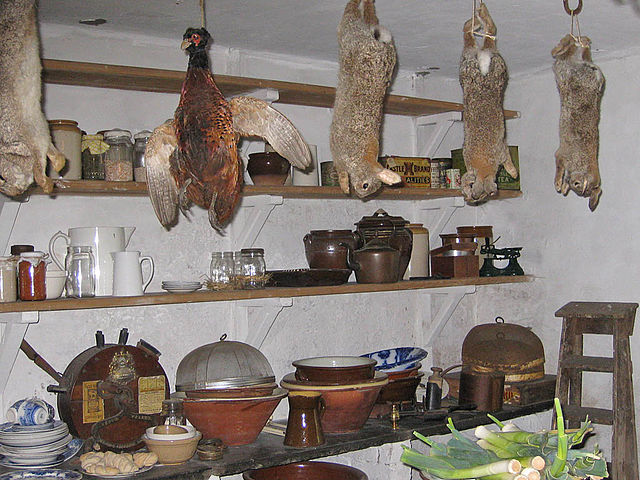

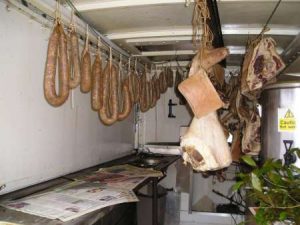




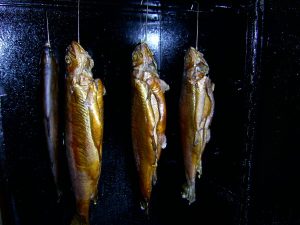
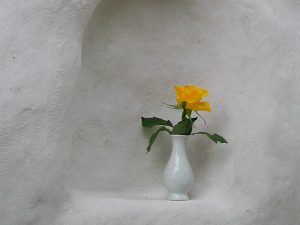
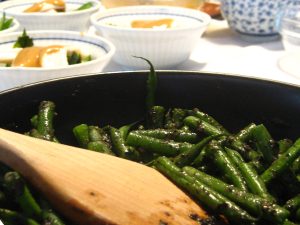
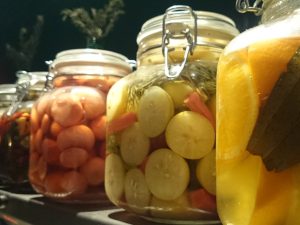
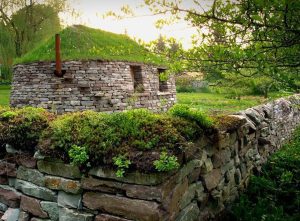
28 Comments
J > I suspect ours is more akin to a pantry, as it is used for dry goods only – not fresh, and certainly not fresh-killed meat. Here in the Outer Hebrides, the air is habitually humid – especially so in the months where a pantry would be most in use. Nonetheless we do have a portion of the wood shed given over to storage of potatoes, and we have slowly evolved the techniques to keep them. Carrots, parsnips, kale, sprouts and such stay out in the garden as we don’t get frosts or snow, but storing of onions and other veg in their natural state is impracticable without recourse to drying (eg herbs), dehydrating (eg hot chillis), pickling and other preserving, and as a last resort – freezing. However the principle of the larder remains: keep things in as near to their natural state, with minimum processing, and above all minimum ongoing use of energy, as possible
We had a small larder under the stairs in our first house which had the traditional marble cold shelf. We also had daily milk deliveries, a butcher, a baker, a general grocer, greengrocer and hardware shop 2 minutes walk around the corner. Milk was use it or lose it for starters in summer, despite an earthenware flowerpot evaporator helping to keep it cool.
My wife was at home to look after our daughter, I had a job that kept us and paid a mortgage. She planned each meal and shopped daily as you couldn’t stock up for a week. Sausages kept for a day in summer, you could buy 3 or 4 or 5 from the butcher..
The second hand fridge we got a month after moving and later new fridge-freezer was liberating and safe.
It was the last days when you could have that lifestyle. Now both partners work to pay extortionate housing costs and supermarkets have killed those local shops.
Post continued..
The modern fridge is a boon – no wonder it is in 99% plus homes. Prior to the fridge, (middle-class?) people had iceboxes and ice was delivered to keep them cool.
Modern fridges and freezers are very efficient although I do think there may be room for improvement and possibly a no input fridge using the evaporation cooling principle.
We have a separate produce store now for home-grown produce but wouldn’t give up the fridge or freezers.
Interesting post, all the same.
It’s worth pointing out that the electricity used by a fridge typically contributes to the heating of the house (unless it’s a freezer or beer fridge in a garage) whereas a larder will lose heat to the outside so needs to be insulated from the rest of the house.
As John Harrison says, modern fridges and freezers are very efficient. Still, the use of evaporation cooling as a substitute seems like a bad idea: either the water (presumably) which is evaporated condenses elsewhere in the house causing possible mould problems or it is ventilated to the outside taking the energy it contains with it. You could condense it with a dehumidifier but then you’d just have built a rather open and inefficient fridge (which has an internal evaporator and condenser, after all).
Good point Ed , I’ll stick with my day job! 🙂
I think the fridge is essential for most people, as there is rarely enough space even for a pantry in modern or small houses. However, the modern obsession with multiple fridges and freezers is beyond my comprehension. I yearn for either a larder or a pantry and long to get rid of the pointless and I practice built in kitchen cupboards I have – I think it will be in a different house some time in the future though. However, I am aiming to increase my stock of home preserved products to cope with gluts from the garden and bulk buys when bargains/good value fruit and veg are discovered.
(“I practice” should read impractical)
My comment above is a bit parochial in that I’m assuming somewhere where the house needs at least some heating for a large proportion of the year. I live in the north of Scotland. Nearer the equator where cooling is more often required, or heating is only needed for only a few months a year, a larder or evaporative cooling, as John Harrison suggests, would make more sense.
Sounds like your storage was badly designed to start with. Having planned thousands of kitchens (it was my job) I know a well planned set up is easy to use. Our current kitchen is designed to maximise storage and for ease of access. Mainly solid deep drawers utilising front to back space as well as linear and vertical. Adds about 20% to the cost on average but it’s a joy to use.
You used to be able to get an under-counter fridge on the same principle but I switched careers in the 90s so out of touch now.
It’s great to hear how your practices have evolved in the context of the Outer Hebrides, Jonathan and Denise. Preserving is a whole other alternative in itself and something I’m keen to try more of too.
It’s good to hear about your experiences of larder use, John. I agree that these days it’s largely impractical to use larders in the context of milk and meat. A separate produce store sounds a great half-way house for home grown fruit and veg, though.
That’s a very good point, Ed. If designing from scratch, to ensure a larder doesn’t compromise the overall thermal efficiency of a house it would ideally be separate from the main thermal envelope of the building.
Space is a definite issue, I agree, Theresa, and such a shame that new build houses are so lacking in this respect. Good luck with the preserving plans in the meantime.
It did strike me that an evaporative cooler could be a boon to those in hot climates but plentiful water. No energy use, very low carbon input into manufacture and above all affordable to those on very low incomes. Improved food safety and reduced wastage. BUT 1) I’m no engineer and 2) I’m only assuming they’d be of value to those in Africa etc. Just the carbon output for making conventional fridges for all those in the world who don’t have them is terrifying.
How do you store your tatties please with wood!? ?
I really like your blogs Sophie! Thanks.
It would seem that a good idea might be to have a solar-powered fan to provide active ventilation? Cheap, low powered items that should be a big benefit in this appplication.
I agree with you that the fridge/freezer is the biggest consumer of electricity in a home, at least one where the owner is careful with electricity use with TVs and gadgets, etc. My fridge/freezer accounts for 3/4 of my electric bill.
Efficiency is something which interests me, and so Ed and John, I’m curious to know why you say that these appliances are very efficient, if you don’t mind. On what do you base this assertion? Is it just the manufacturer claims? I know what you will probably say, which is that they don’t waste much energy when operating, but this is not what I mean, when you consider the wider picture. If they are using grid electric then the efficiency will always be very low because of the low conversion efficiencies of the power stations supplying the grid and the losses inherent within the grid. Marketable energy is very wasteful.
To me, I would consider them efficient if the cost of/time saved in running a fridge/freezer outweighed the cost of paying for daily high price corner-shop fruit/veg/milk perhaps, or the time (and maybe travel costs) of getting it. It would be interesting for you to do some calculations on this basis. They are unlikely to break, so that is something that goes in their favour. I keep mine because I store soft fruits in the freezer section, and that is the only reason that I have one, so really it is a bit of a guilty pleasure.
Hi Andrew. I’d been meaning to join this thread, but got distracted. You’re touching on the kinds of things that were niggling me. I think my concerns break down into two main categories.
First – yes, what is meant by ‘efficient’? We’re headed for a world of ten billion people, which means probably two or three billion households. Now if we in the West find a fridge freezer ‘essential’, then we can’t morally deprive other people of them. If your average electrical appliance lasts 10 years (?), then we’re looking at building the mining, transport, manufacturing, distribution, sales and electricity networks to produce and run 2-3 billion fridge-freezers every ten years. And then of course there are all the other things that are ‘essential’ – TVs, dishwashers, cars, flights, electric toothbrushes. Can ten billion people have all those things (and when they’ve got one home full of those things, then to help the economy grow, they’ll be persuaded that it might be a good idea to have a second home full of those things)? Considering that peer-reviewed ecologists are telling us clearly that we’re already headed for ‘biological annihilation’ (http://www.lowimpact.org/should-we-not-mention-whats-happening-to-the-biosphere-in-case-it-scares-the-mainstream/), I’d say the answer to that is no.
Second – say, just say, that modern civilisation collapses. It doesn’t sound so crazy as it used to, does it? I’m sure if you sat down for ten minutes you could come up with several ways that it might happen – ways that are not looking that unlikely. So if there are no factories producing fridge-freezers, and no electricity grid to power them, we’re going to wish we’d worked out how to build and manage efficient larders.
Or am I being alarmist?
(we’ve also got a fridge-freezer, so let me get in there first to point out my hypocrisy before anyone else does).
A big part of the problem with fridges and most manufactured goods is their short lifespans. I don’t know but suspect the energy/resources/carbon footprint of making a fridge is far in excess of the electricity used. One of our freezers is at least 30 years old. It would probably get a C rating if sold new today but surely the marginal difference in energy compsumption is compensated by the initial cost divided by years of use. Maybe a lefespan rating as well as an energy efficiency rating would be a good idea – but that doesn’t promote profit.
Also other methods of preserving such as chutneys, jams, bottling etc all use a lot of energy. At least electricity can be green with solar, wind etc.
If we’re brutally honest with ourselves, the best option for long term survival on planet Earth is a terrible plague wiping out 50%+ of humans. Any volunteers to die?
The problem is we’re obsessed with energy consumption. I read an article a few weeks ago about ‘human power’ (it might have been on this site) something most people rely on very little these days – a food processor to do things our mothers and grandmothers would have done with graters, mincers, mandolins and so on. We can’t push lawn mowers any more, or read paper books, it all has to be done with gadgets. All to save time… If we reviewed what was really useful and ditched the rest, we’d be on the right road to reducing energy consumption.
John – I prefer not to put the blame on the number of people on the planet – I think it’s about whether we respect nature’s limits or not. There are plenty of people who will brand you as racist if you identify population as the problem, because the vast majority of the extra (at least) 3 billion people who are coming will be dark-skinned. I understand why they would say that, but I’d respond that if we’re happy with a global population of ten billion, or even eleven or twelve billion, then so be it, but we can’t have cars, flights, or get our clothes, electrical appliances and food (for god’s sake) from the other side of the world. Which is fine by me – let’s re-organise ourselves so that we don’t need to travel far, and everything we need is produced locally. But that’s not looking likely – everyone wants an American (material) standard of living, in which case there needs to be far, far fewer of us, or we won’t last long.
Theresa – yes, it was here – http://www.lowimpact.org/human-power-plant-experiment/.
To be fair, if you can read thousands of books on a tablet of some sort, it might require less energy than making the paper, printing and distributing thousands of books. But you’re right – if we ditched the unnecessary things in our lives, it would benefit us as well as nature. That attitude is not good for economic growth though, unfortunately, which is the goal of every government, and is assumed to be an unqualified good by corporate media, which is where most people get their information.
I’m a bit shocked to think I may be accused of being racist – the race of the coming 3 billion was not something I even thought of. People of any colour are going to resist being limited materially when others have the goodies. And those with the goodies are really going to resist giving them up.
We’ve published two or three articles over the years suggesting that population might be something we want to look at if we’re going to sustain human life on earth, and on each occasion, we’ve had a smattering of FB responses along the lines of ‘you’ve joined the ranks of (insert abusive name here) who want to limit the number of dark-skinned people; I’m unfollowing you – goodbye’. I understand their frustrations – that the real engine of ecological destruction is the Western, growth-oriented corporate / financial sector, the higher echelons of which are very, very white (the snowy white peaks, as my mrs. would say). But to refuse to talk about sheer numbers is a mistake, I think. But I suppose if we’re going to talk about it, rather than sweep it under the carpet, we have to be prepared for responses like that.
We’ve gone a bit off-piste as regards larders, though.
On a further larder-related note, I’ve just come across this proposed new small-scale affordable sustainable housing development near Chichester, proudly featuring a larder in each of the 10 properties: https://www.facebook.com/NoreDownWayEcoHousing/posts/284618701945029 (and a greenhouse, bicycle storage and electric car charging points).
Hi, Interesting thread, sorry for the late reply. We too live in the far North of Scotland and have retrofitted a larder in our kitchen. We have a suspended timber floor and have drilled a 4” hole in that, covered with a grill. We also drilled a (horizontal) hole in the outside wall around 6’high, also approx 4” Dia also with a grill on the inside. This arrangement creates a thermal siphon and works extremely well, even although the end wall is South facing.
The larder consists of 2 outside walls with (one length, one breadth) insulated timber framing on the other 2 walls.
We have also used the thermal siphon system in our recycled chest freezer that is sunk in the ground, up to the lid level, and this also works very well for storing veg’.
Thanks for such a fantastic site, keep up the great work!
Malcolm
Hi. On the population issue, surely the key is to get people to realise that having lots of material possessions and luxury will never give people happiness, contentment, peace and love. Which is surely what the vast majority of people want? So, there is no need then for other countries to pursue what the West has, given that it is pretty clear that we have messed up, (if we all understand this there is not the pressure on population growth, although it still is of course a topic that needs discussion). The question is ‘how do we get that clear message across’?
Many people on this site already realise this situation but it seems the majority of the population, at the moment, have been brainwashed with ‘economic growth at all costs’ and ‘you must keep up with the Jones’s’ which is really one and the same thing.
Warm regards
Malcolm
Hello,
Going back to larders… We’re planning an off-grid food store for our market garden produce. We have solar panels, so using some kind of power is possible. I’m wondering if there are any good ideas for keeping cool out there? Thanks,
Gus
I turned a very untidy broom cupboard into a walk in larder in my council flat. It faces north and has an airbrick i covered with meshed metal(cheap off ebay). I turned one shelf into a cool shelf by covering it with marble chopping boards,ebay again. I keep fruit and veg in plant pots on the concrete floor. I do have a tiny freezer in my kitchen,so I have a plastic cool box for meat with a fresh freezer block swapped over every 12 hours. I eliminated larder mites with Food Grade diatomaceous earth sprinkled lightly on each shelf,ebay again. I can keep fresh food for weeks,see everything ive got at a glance. I have a stick on blackboard on the back of the door,so if anything runs out I chalk what I need on it,ebay again. So it can be done even in a small place.